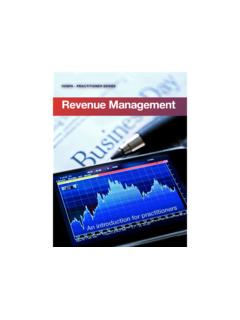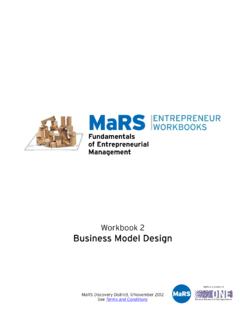Transcription of Supply Chain Decision-making - Sourcetrix
1 Steve Lewin, Sourcetrix Corp. Page 1 Supply Chain Decision-making by Steve Lewin, Sourcetrix Corporation Executive Summary A large collection of tools, technologies, and methodologies is being thrust on executives today in every area of business, including the Supply Chain management space. Seminars and books abound. Periodicals are everywhere. Solutions proliferate. A comprehensive perspective that will organize and categorize the good, the mediocre, and the bad remains elusive. Yet, increasing the value of the corporation stands as an unyielding objective. Executives must answer this question: How much consistent positive pressure will a given initiative exert on the value of my company?
2 Higher value for the enterprise often resides dormant in the Supply Chain . It is there for the taking for those executives who can see through the fog of propaganda and the plethora of possible projects to focus with clarity. The catalyst of executive support must be applied with precision in order to improve Supply Chain decisions. These decisions drive operational capabilities that result in financial metrics, which, in turn, determine corporate performance. Specifically, the quality of the decisions pertaining to inventory and Supply Chain flexibility reflect in the value accrued to the enterprise.
3 Figure 1 traces this linkage, borrowing from a financial perspective on the balanced scorecard Figure 1. Steve Lewin, Sourcetrix Corp. Page 2 These inventory and feasibility decisions determine the position of the fulcrum for the Supply Chain lever (Figure 2). More timely and higher quality decisions in the optimize inventory and optimize Supply Chain flexibility spaces (boxes outlined in yellow under " Supply Chain Decisions" in Figure 1) move the fulcrum in Figure 2 to the left. This amplifies the force that Supply Chain capabilities exert on key financial metrics, creating more Economic value Added2 (box with yellow outline at the far right in Figure 1).
4 Steve Lewin, Sourcetrix Corp. Page 3 Figure 2. Benefits of Improving the decision Process Consider the challenge faced after a merger or acquisition. The challenge of rationalizing warehouses, distribution centers and even production facilities is a decision in the Supply Chain flexibility space. The rationalization exercise is non-trivial, but can drastically impact cash flow, as well as balance sheet and income statements. In the inventory decision space, globally deciding what to move, make and buy in a way that recognizes the various risks can enable a firm to lower its purchase price, eliminate expediting costs, free precious cash flow, and improve customer service.
5 This is not to say that other business improvement projects cannot enhance corporate performance. Interdependencies among all facets of the business imply that a focus on one area to the detriment of others will not succeed. For example, without a strong product strategy, effective target marketing, and appropriate pricing, Supply Chain efficiency and effectiveness will be insufficient to increase enterprise value . The point here is that providing you have a minimum level of efficacy in marketing and transaction capabilities, improving the decision process around inventory and Supply Chain flexibility will drive sustainable, measurable benefits in the near term that are disproportionate to the effort required.
6 It is assumed, of course, that the decisions made are executable. In many cases, the most important Supply Chain decisions can be actionable, even without new execution systems for order management, warehouse management, purchasing, costing or accounts receivable. In Steve Lewin, Sourcetrix Corp. Page 4cases where good decisions cannot be executed because basic business transactions are not accurate or timely, then the sustainable viability of the business may be in question. A sustainable increase in valuation must give way to a fire drill for survival. Keeping Perspective Corporate Objectives All MBA graduates have been taught to accept the tenet that the object of management is to increase shareholder wealth.
7 Presumably, the interests of all of the other stakeholders could, or even should, be subjugated in favor of shareholder wealth. One might argue that as shareholder wealth increases, all other interested parties benefit. Another point of view might be that, while the interests of all stakeholders may not be of equal import to management, they should all be considered, and that in doing so, shareholder wealth will be enhanced over the long term. For the purposes of this discussion, it is assumed that the objective is, indeed, to increase shareholder wealth -- to increase the value of the enterprise in which the shareholders have invested, and therefore, the value of their shares.
8 The Nature of the Supply Chain Before launching into the logic behind the thesis in this article, it is in order to review the concept behind a term that has very much come into vogue (and into some abuse as well), namely, Supply Chain . There are three basic functions in a typical business organization: finance, marketing, and production/operations, excluding support and infrastructure. Stevenson3 describes all of the activities that are directly related to producing goods or providing services as part of operations. He defines operations as activities that add value during the transformation process into which inputs are received and from which outputs are delivered.
9 Inputs and outputs can be products, services or information. The people and assets involved in acquiring the inputs and performing and delivering the transformation make up the Supply Chain . That a Supply Chain stretches beyond a lone enterprise is not news. Organizations have always received inputs from a supplying entity and delivered outputs to a consuming company or person. Each organization provides an interdependent link in the value -adding transformation process, otherwise known as the Supply , or value , Chain . In fact, this is seldom a single strand of activities, but rather an interdependent network comprised of many value -adding nodes, each of which receives many inputs and combines them in various ways in order to deliver numerous unique outputs for multiple consuming nodes.
10 Organizations that receive outputs (customers) pay for the value added in the transformation process. It is, perhaps, more properly designated the value network through which many value or Supply chains can be traced. Steve Lewin, Sourcetrix Corp. Page 5If each node in the value network makes decisions in isolation, the potential grows for the total value in one or more Supply Chain strands to be less than it could be. In the best of all possible worlds, each node would eliminate activities that do not add value to its own transformation process such that it can reap the highest possible margin, subject to maximizing and maintaining the total value proposition for a Supply Chain .





